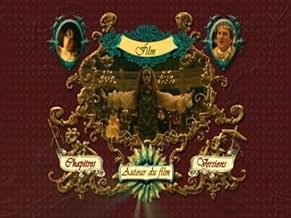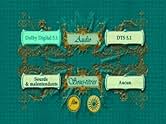Le roi danse
- 2000
- Tous publics
- 1h 55m
Corbiau repeats the Farinelli formula, artistic rivalry and social private drama expressed in dazzling, sometimes excessively lavish baroque scenery, music and costume, but this time in its ... Read allCorbiau repeats the Farinelli formula, artistic rivalry and social private drama expressed in dazzling, sometimes excessively lavish baroque scenery, music and costume, but this time in its ultimate setting: Versailles. There are two protagonists - first the title character, Loui... Read allCorbiau repeats the Farinelli formula, artistic rivalry and social private drama expressed in dazzling, sometimes excessively lavish baroque scenery, music and costume, but this time in its ultimate setting: Versailles. There are two protagonists - first the title character, Louis XIV, the French sun-king who has two passions, establishing absolute rule over the realm... Read all
- Awards
- 1 win & 5 nominations total
- Prince de Conti
- (as Idwig Stephane)
Featured reviews
The same reviewer complained that the actors playing Molière, Conti and Cambert were much too old, that all three were closer to Louis' age. What bothered me more than the wrong ages of some of the supporting characters was the fabulous gorgeousness of the actors who played Louis and Lully. Please! There are good portraits of both men, and both of them were as homely as my aunt Gertrude - especially Louis.
That a man who looked like a gargoyle dwarf (he was only a few inches over five feet tall), saddled at the age of four with a bankrupt, strife-torn, second-rate country, transformed himself into the Sun King and his country into a major world power, and by the force of his will completely dominated Western civilization for nearly a century - and STILL, more than 300 years later, and despite the horrific revolution that destroyed the world he created, is the single most significant person in the history of France (only Napoleon comes close, and he was a flash in the pan compared to Louis) - is a big part of what makes him so extraordinary. If he had looked like Benoît Magimel, what would be the big deal? Gorgeous people automatically control the world; they don't have to DO anything. Louis is fascinating because he was NOT gorgeous, and making him gorgeous wipes out 75% of what makes him interesting.
The answer to both that reviewer's and my beefs with this movie is that its makers had no intention of making an historically accurate quasi-documentary about this fascinating man and the almost equally fascinating people around him. They intended to make an overblown, potboiler soap opera based loosely on real people. They made the principals gorgeous because who cares what happens to ugly people? They made the villains grotesque and old because if they had been young we might not have known they were the villains.
This is a French movie, but it might as well have been made in Hollywood. It is cheap (and I'm not talking about money) melodrama, with gorgeous, dashing heroes and old, ugly, hunched-over, troll-like villains with grotesque birthmarks on their faces. It was NOT made for experts in French history or any other persons of intelligence and discernment.
It was made for an audience that neither knows nor cares how accurate it is or who the people in it are. That's how Hollywood does everything, by formula - the same formula they used in silent westerns, where you knew the good from the bad guys by the color of their hats - so audiences don't have to think, don't have to understand anything. They know by their looks which characters to cheer and which ones to boo, and that's all that matters.
I had the fortune of meeting the choreographer of the film, Béatrice Massin, who attended the screening. She is THE authority of Baroque dance in France, after having worked with Francine Lancelot, who was the pioneer in the restoration of Baroque dance into its original form. Massin works with original dance notation materials from Louis XIV's time, especially the Feuillet notations, which provided very detailed and exact instructions on the dance steps used at Louis XIV's court. This dance form is very important because it is the origin of today's ballet, which has gone through a lot of transformations, especially from that of a male-only art form to one where the female dancer dominates the stage.
During production, Massin worked with the lead roles in the movie every day for three months, and she has high regard for Benoît Magimel. Though not a professional dancer, he attempted all the dance sequences with courage, never uttering the words "I can't." Of course, the repertoire of Baroque dance was wide-ranging and Massin could not possibly have included all the varieties of that era. She mainly worked in such a way to show what the director wanted. In the context of this movie, the director had wanted to show the masculine power that the king wanted to demonstrate, as a way to consolidate his power on the throne. So what we see in the movie comes across as very forceful, masculine movements.
One thing that the film has left out - what Massin feels as a mistake - is the character of Pierre Beauchamps. Beauchamps was the key dance master at Louis XIV's court and was responsible for dance education and choreographer, although he was also a musician - not as accomplished as Lully at that, while Lully's dancing skills would pale alongside Beauchamps'. In fact, Lully, Beauchamps and Molière were working very closely together. For me, it is a big, big regret that this movie, whose theme is Louis XIV's passion and talent for dance, has treated Beauchamps in such a dismissive manner (the only scene where he appeared was when the king asked him to leave the room and rearrange the choreography, to give it "more air!").
Another thing that I miss seeing is the establishment of l'Académie Royale de la Dance. Surely, the film shows that the king announced it in a royal decree as soon as he took over all the power upon Mazarin's death. But it would have been nice to see a snippet of the academy's activities, such as how the first group of professional ballet dancers were trained.
Unlike what some of the commentators here have said, though, I think that the film does have a deep aspect. The idea that Louis XIV cared so much about the art of dance and music and Lully's concept of music being something to make the king immortal -- points to the transcending nature of these arts. Although dance and music was used as much as a political tool for power as a form of entertainment at the court, I personally feel that the passion for dance and music - as a pure form of truth and beauty - is powerfully expressed through the dramatic performances of the actors and actresses in this film.
Anybody who loves the subject of Louis XIV, Baroque music, dance and ballet should go and see this film.
Did you know
- TriviaThe small violin Lully plays when conducting the orchestra is called a 'pochette', so called because it could be carried in a coat pocket.
- ConnectionsFeatured in L'aventure humaine: La véritable histoire de d'Artagnan (2021)
- SoundtracksTe Deums: Symphonie
Written by Jean-Baptiste Lully
Conducted by Reinhard Goebel
Performed by Musica Antiqua Köln
- How long is The King Is Dancing?Powered by Alexa
Details
- Release date
- Countries of origin
- Official sites
- Language
- Also known as
- The King Is Dancing
- Filming locations
- Production companies
- See more company credits at IMDbPro
Box office
- Budget
- $21,000,000 (estimated)
- Gross worldwide
- $3,203
- Runtime1 hour 55 minutes
- Color
- Sound mix
- Aspect ratio
- 2.35 : 1
Contribute to this page




























